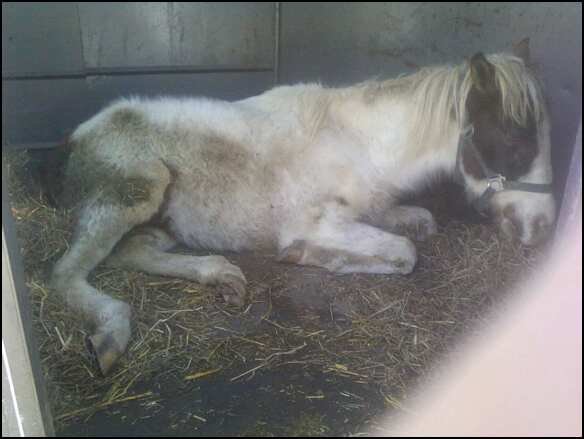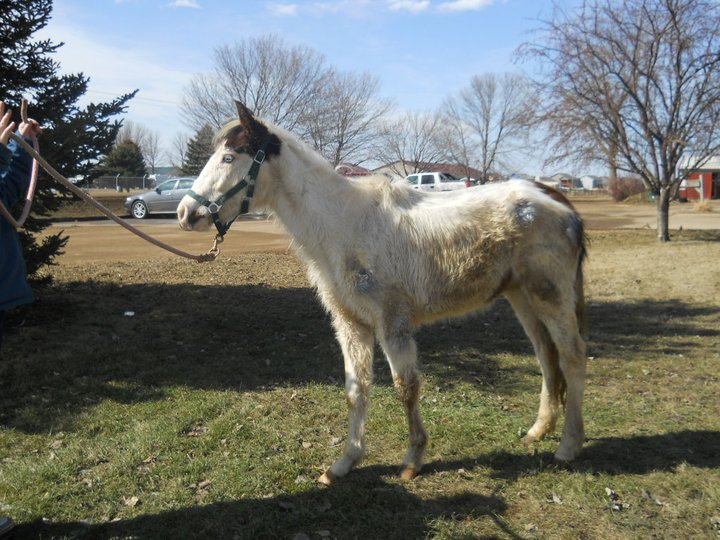Millie — The Filly Who Refused to Give Up
In February 2011, long before we had systems, protocols, or even a full understanding of what rescue work would demand of us, a coming two-year-old filly changed the trajectory of our organization. We were told her parents were Two Tone Twin and Million Dollars, and while we never registered her ourselves, her name came easily: the Million Dollar Miracle — or Millie, for short.
She arrived in the very early days of Gentle Spirit Horses — a time when every new case taught us something we didn’t yet know. And Millie would go on to shape how we handle starvation cases and refeeding syndrome for the next decade and a half.
It began with a Facebook post — a thin, dull-eyed yearling advertised as “needing a new home.” She didn’t look good, but she was still on her feet. Before we could arrange pickup, the seller called to say that another horse on the property had died overnight, and Millie had gone down after being treated for mites. When we arrived, Millie was still unable to stand. We tucked a blanket around her and called the local vet, who examined her and told us something we clung to: she needed to leave the property immediately, but she still had a real chance to recover. With no safe way to move her otherwise, the owners used the bucket of their skid loader to gently lift her into our trailer for the trip to safety.

Millie spent the next three days down in that trailer under close veterinary direction, with volunteers rolling her multiple times a day and adjusting her position to prevent further damage. By day three, we faced the first of several impossible deadlines: if she couldn’t get up that day, we would have to let her go. Weak and trembling, Millie somehow found her feet — the first of many times she would choose life when her body could barely keep up.

This was 2011, and the UC Davis Refeeding Protocol had only recently begun circulating outside academic circles. Most horse people had never heard of refeeding syndrome, and many pushed back against the idea that feeding too much too soon could be fatal. But we had already seen early reports of rescues losing emaciated horses after intake, and our vets were among the few in the region who were aware of the new research. So we followed their guidance: tiny amounts of alfalfa only, fed six times a day. No grain, no sweet feed, no grass hay — just the careful, science-backed approach that kept Millie stable enough to keep fighting.
After four weeks of slow progress, she was finally strong enough to make the trip from north-central Iowa to South Dakota — though she still needed help to stand. She was admitted to the vet hospital for intensive care, given a ten-day timeline to get herself up without assistance, and once again, she met the deadline just in time. From there her recovery accelerated. Muscle returned. Energy came back. Her eyes brightened. She transformed before our eyes.

And she did it with a partner. A volunteer who had been visiting her regularly at the vet clinic fell in love with her — not with who she might become, but with the fragile, determined filly she already was. When Millie was cleared to leave the hospital, she went straight into that volunteer’s care to continue her rehabilitation. At the boarding barn, a sign hung outside her stall explaining her story — partly as warning, partly as celebration, and partly to help others understand just how far she had come. Within a year, she was strong enough for light riding. A few years later, she was exploring trails, decked out in pink and turquoise, looking nothing like the 397-pound filly we first met.

Millie taught us three lessons that continue to guide our work today:
Science saves lives — when it’s used appropriately.
The UC Davis Refeeding Protocol isn’t for horses who are simply a little thin. It’s meant for the truly emaciated, and when used in the right cases — like Millie — it can mean the difference between life and death.
Time is one of the most powerful tools in rescue.
Not every horse recovers quickly. Some need days just to stand, and weeks before their bodies can handle real nutrition.
The right person at the right moment can change everything.
Millie’s adopter didn’t just give her a home — she helped finish the story we started.
Today, Millie is everything a rescued horse should be: bright, cherished, sound, and safe. Most people who meet her now have no idea what she endured or how close she came to not surviving. But we remember — because Millie didn’t just recover. She helped shape who we became.
Dare to Care with Us
Millie’s story reminds us that rescue is both science and heart — tiny steps forward, long nights, and the belief that even the frailest horse deserves a chance to stand again. Horses like Millie survive because people choose to show up.
Your support helps us give that same chance to the next horse who needs it — the ones who arrive starving, scared, down, or simply waiting for someone to believe in them. When you Dare to Care with us, you become part of every miracle that follows.
👉 Give today at https://givebutter.com/c/2025christmasponies
Thank you for helping the next little horse who needs a place to land — and a reason to get back up.
